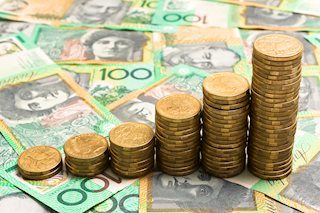AUD/USD slides to fresh daily low, eyes 0.6500 mark amid notable USD demand
|
- AUD/USD meets with a fresh supply on Thursday amid a strong pickup in the USD demand.
- China’s economic woes and diminishing odds for further RBA rate hikes weigh on the Aussie.
- A positive risk tone could help limit further losses ahead of the key US NFP report on Friday.
The AUD/USD pair attracts fresh sellers following an intraday uptick to mid-0.6500s and drops to a fresh daily low during the early part of the European session on Thursday. Spot prices currently trade around the 0.6515 region and for now, seem to have stalled the previous day's goodish rebound from the lowest level since early May.
The US Dollar (USD) makes a solid comeback from the vicinity of a three-week low touched on Wednesday in the aftermath of the FOMC policy decision and turns out to be a key factor exerting downward pressure on the AUD/USD pair. Apart from this, persistent worries about a slowdown in China – the world's second-largest economy – undermines the China-proxy Australian Dollar (AUD) and contributes to the downfall.
A private survey showed that business activity in China's manufacturing sector unexpectedly shrank in July for the first time in nine months, underscoring economic woes. Furthermore, the mixed Australian consumer inflation figures on Wednesday dashed hopes for further rate hikes by the Reserve Bank of Australia (RBA), which should weigh on the Aussie and support prospects for a further depreciating move for the AUD/USD pair.
Meanwhile, the Federal Reserve (Fed) acknowledged the recent progress on inflation and cooling in the labor market. Adding to this, Fed Chair Jerome Powell, speaking at the post-meeting press conference, signaled the likelihood of an early rate cut if inflation stays in line with expectations. This, in turn, drags the US Treasury bond yields to a multi-month low, which, along with a positive risk tone, should cap the safe-haven Greenback.
This, in turn, could offer some support to the risk-sensitive Aussie and help limit the downside for the AUD/USD pair. Traders might also refrain from placing aggressive directional bets and prefer to wait for the release of the closely-watched US monthly employment details – popularly known as the Nonfarm Payrolls (NFP) report on Friday. Hence, any subsequent fall could find decent support near the 0.6500 psychological mark.
RBA FAQs
The Reserve Bank of Australia (RBA) sets interest rates and manages monetary policy for Australia. Decisions are made by a board of governors at 11 meetings a year and ad hoc emergency meetings as required. The RBA’s primary mandate is to maintain price stability, which means an inflation rate of 2-3%, but also “..to contribute to the stability of the currency, full employment, and the economic prosperity and welfare of the Australian people.” Its main tool for achieving this is by raising or lowering interest rates. Relatively high interest rates will strengthen the Australian Dollar (AUD) and vice versa. Other RBA tools include quantitative easing and tightening.
While inflation had always traditionally been thought of as a negative factor for currencies since it lowers the value of money in general, the opposite has actually been the case in modern times with the relaxation of cross-border capital controls. Moderately higher inflation now tends to lead central banks to put up their interest rates, which in turn has the effect of attracting more capital inflows from global investors seeking a lucrative place to keep their money. This increases demand for the local currency, which in the case of Australia is the Aussie Dollar.
Macroeconomic data gauges the health of an economy and can have an impact on the value of its currency. Investors prefer to invest their capital in economies that are safe and growing rather than precarious and shrinking. Greater capital inflows increase the aggregate demand and value of the domestic currency. Classic indicators, such as GDP, Manufacturing and Services PMIs, employment, and consumer sentiment surveys can influence AUD. A strong economy may encourage the Reserve Bank of Australia to put up interest rates, also supporting AUD.
Quantitative Easing (QE) is a tool used in extreme situations when lowering interest rates is not enough to restore the flow of credit in the economy. QE is the process by which the Reserve Bank of Australia (RBA) prints Australian Dollars (AUD) for the purpose of buying assets – usually government or corporate bonds – from financial institutions, thereby providing them with much-needed liquidity. QE usually results in a weaker AUD.
Quantitative tightening (QT) is the reverse of QE. It is undertaken after QE when an economic recovery is underway and inflation starts rising. Whilst in QE the Reserve Bank of Australia (RBA) purchases government and corporate bonds from financial institutions to provide them with liquidity, in QT the RBA stops buying more assets, and stops reinvesting the principal maturing on the bonds it already holds. It would be positive (or bullish) for the Australian Dollar.
Information on these pages contains forward-looking statements that involve risks and uncertainties. Markets and instruments profiled on this page are for informational purposes only and should not in any way come across as a recommendation to buy or sell in these assets. You should do your own thorough research before making any investment decisions. FXStreet does not in any way guarantee that this information is free from mistakes, errors, or material misstatements. It also does not guarantee that this information is of a timely nature. Investing in Open Markets involves a great deal of risk, including the loss of all or a portion of your investment, as well as emotional distress. All risks, losses and costs associated with investing, including total loss of principal, are your responsibility. The views and opinions expressed in this article are those of the authors and do not necessarily reflect the official policy or position of FXStreet nor its advertisers.